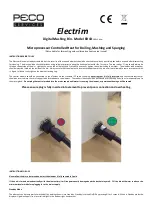
occasion when there is a high risk of unavoidable or accidental contact with the work
piece or ground. Must use additional safety precautions: semiautomatic DC constant
voltage (wire) welder, DC manual (Stick) welder and AC welder with reduced open-
load voltage.
Maintain the electrode holder, ground clamp, welding cable and welding machine in
good, safe operating condition. Replace damaged part immediately.
Electric and magnetic fields (EMF) may be dangerous.
interference is found to be occurring, the operator is obliged to examine any possible
electromagnetic problems that may occur on equipment as follow:
- Minas, signal and data-transmission leads
- IT and telecoms equipment
- Measurement and calibration devices
- Wearers of pacemakers
Measures for minimizing or preventing EMC problems:
- Mains supply
If electromagnetic interference still occurs, despite the fact that the mains connection
in accordance with the regulations, take additional measures
- Welding cables
Keep these as short as possible.
Connect the work cable to the work piece as close as possible to the area being
welded.
Lay them well away from other cables.
Do not place your body between your electrode and work cables.
- Equipotential bonding
- Workpiece grounding (earthing)
- Shielding
Shield the entire welding equipment and other equipment nearby.
If electromagnetic
ARC rays can burn.
Wear an approved welding helmet or suitable clothing made from durable
flame-resistant material (leather, heavy cotton, or wool) to protect your
eyes and skin from arc rays and sparks when welding or watching.
Use protective screens or barriers to protect other nearby personnel with
suitable, non-flammable screening and/or warn them not to watch the arc
nor expose themselves to the arc rays or to hot spatter or material.
Visible and invisible rays can burn eyes and skin.
Fumes and gases can be dangerous.
breathing these fumes and gases can be hazardous to your health.
When welding, keep your head out of the fume. If inside, ventilate the area at the arc
to keep fumes and gases away from the breathing zone. If ventilation is not good,
wear an approved air-supplied respirator.
Work in a confined space only if it is well ventilated, or while wearing an air-supplied
respirator.
Welding fumes and gases can displace air and lower the oxygen level causing injury
or death. Always use enough ventilation, especially in confined areas, to insure
breathing air is safe.
Welding may produce fumes and gases,
3
Summary of Contents for Dura ARC160
Page 31: ...MEMO ...




































